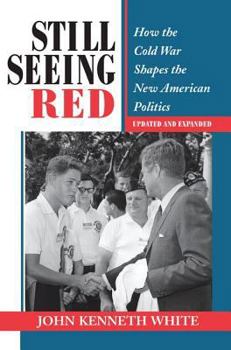Still Seeing Red: How the Cold War Shapes the New American Politics
Select Format
Select Condition 
Book Overview
In Still Seeing Red, John Kenneth White explores how the Cold War molded the internal politics of the United States. In a powerful narrative backed by a rich treasure trove of polling data, White takes the reader through the Cold War years, describing its effect in redrawing the electoral map as we came to know it after World War II. The primary beneficiaries of the altered landscape were reinvigorated Republicans who emerged after five successive defeats to tar the Democrats with the ?soft on communism? epithet. A new nationalist Republican party?whose Cold War prescription for winning the White House was copyrighted to Dwight Eisenhower, Richard M. Nixon, Barry Goldwater, and Ronald Reagan?attained primacy in presidential politics because of two contradictory impulses embedded in the American character: a fanatical preoccupation with communism and a robust liberalism. From 1952 to 1988 Republicans won the presidency seven times in ten tries. The rare Democratic victors?John F. Kennedy, Lyndon B. Johnson, and Jimmy Carter?attempted to rearm the Democratic party to fight the Cold War. Their collective failure says much about the politics of the period. Even so, the Republican dream of becoming a majority party became perverted as the Grand Old Party was recast into a top-down party routinely winning the presidency even as its electoral base remained relatively stagnant.In the post?Cold War era, Americans are coming to appreciate how the fifty-year struggle with the Soviet Union organized thinking in such diverse areas as civil rights, social welfare, education, and defense policy. At the same time, Americans are also more aware of how the Cold War shaped their lives?from the ?duck and cover? drills in the classrooms to the bomb shelters dug in the backyard when most Baby Boomers were growing up. Like millions of Baby Boomers, Bill Clinton can truthfully say, ?I am a child of the Cold War.?With the last gasp of the Soviet Union, Baby Boomers and others are learning that the politics of the Cold War are hard to shed. As the electoral maps are being redrawn once more in the Clinton years, landmarks left behind by the Cold War provide an important reference point. In the height of the Cold War, voters divided the world into ?us? noncommunists versus ?them? communists and reduced contests for the presidency into battles of which party would be tougher in dealing with the Evil Empire. But in a convoluted post?Cold War era, politics defies such simple characteristics and presidents find it harder to lead. Recalling how John F. Kennedy could so easily rally public opinion, an exasperated Bill Clinton once lamented, ?Gosh, I miss the Cold War.?
Format:Paperback
Language:English
ISBN:0813318890
ISBN13:9780813318899
Release Date:September 1998
Publisher:Routledge
Length:448 Pages
Weight:1.35 lbs.
Dimensions:1.2" x 6.0" x 9.0"
Customer Reviews
1 rating
Good general history, but not thorough
Published by Thriftbooks.com User , 18 years ago
Professor White (an ironic name of author, for those who know their Russian civil war) has written an overall good account of American cultural and political perceptions during the cold war. The thoroughness of his research gives him the four stars, but the fifth is withheld because, I feel, his focus is much too narrow. Instead of the cold war shaping American values, a broader glance at the historical record shows that it was American values that shaped the cold war. There is a straight line of continuity from McCarthyism to the Red Scare of 1920, and beyond that to the anti-IWW scare prior to WWI and the anti-anarchist craze in the wake of the Chicago Haymarket bombing of 1886. Linked to the anti-radical rhetoric were not only powerful business interests and their militant anti-labor stand, but even longer currents of anti-immigrant, anti-Catholic Know-Nothingism - as well as perennial racism and white supremacy. Thus Professor White also does not dig deeper analytically, to ask WHY America is anti-Communist. He is content to take the formulation of "liberal American values" vs. Communist totalitarianism pretty much at face value. Those of us who lived through the period will agree, like it or not, that despite the liberal rhetoric anti-Communism served to protect deeply conservative, even reactionary values. Like "anti-terrorism" now, with its Patriot Act, anti-Communism served to criminalize dissent. Thus Martin Luther King could be seriously branded a "Communist agent" by the supreme national policeman, J. Edgar Hoover; or anti-war protestors were labeled "un-American traitors" for disagreeing with their government; or Nazi collaborators from Eastern Europe could find shelter in the U.S. as seekers of freedom from Captive Nations; or branding non-alignment of Third World nations "the same as Communism," justifying old patterns of conquest in new guise; that discrimination, blacklisting, and clandestine surveillance in violation of the most fundamental liberal principles were justified in the name of "defending freedom"; or how this defense of freedom was intimately linked to the rising profits of the military-industrial complex and the oil industry. Professor White is right in his title: America is "still seeing red." The Cold War lives on in the rhetoric of Dubya Bush and his Washington Politburo. But without America's long legacy of anti-radicalism, knee-jerk conservatism, and anti-intellectualism, the post-WW II Cold War era itself could not have been possible.






